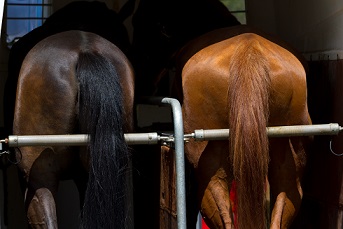 Every year we get many calls from floating accidents and whilst some are just bad luck, others could have been prevented.
Every year we get many calls from floating accidents and whilst some are just bad luck, others could have been prevented.
Here are some important factors to consider when traveling with horses:
The Vehicle
- Check your car/truck and its tyres can legally tow a float with horses in it
- The tyres are at optimum pressure.
The Float
- Check the tyre pressure is correct
- All lights are working on your float – there needs to be tail lights, brake lights, indicator lights, and a number plate light
- Your float is free of rust, especially the floor, as we have heard of some horrific accidents where horses have fallen through a rusty floor.
- Keep in mind if you discover your indicator or brake lights aren't working then you must use hand signals to indicate to other road users your intentions
- It is best if all four float wheels can brake.
- Make sure to sweep, hose, and air out your float after travel to prevent mould and leaving anything behind that might encourage vermin.
The Horse
Floating can be a very scary experience for some horses if they have never done it before. Even if they have floated before, a bad experience can make them very difficult to travel with again.
If your horse has floated before, check to see what kind of float this was and what kind of experiences they had in it. Some horses prefer angle-load floats or trucks because they appear bigger inside.
If your horse has only traveled before in an angle-loading float or truck, be wary of traveling them in a straight-loading float as they may try and go forward and through the window. We have seen a few of these accidents now and they are very scary for both owner and horse. If you have to travel them in a straight load float for the first time and/or they are nervous, consider covering the window to make them feel more enclosed and so they can't see a way out.
Some horses prefer to travel with a friend and others prefer to go solo. Unfortunately there's no hard and fast rule when it comes to this as each horse is an individual, so if it is possible you can try traveling both ways to see which they prefer.
There are many measures owners put in place to ensure that their horse is safe when traveling, including the wearing of rugs and floating boots.
Checking Rugs:
if you do wish to rug them, check it will not be too hot and cause them to overheat. Make sure that there is nothing on the rug which could get stuck on the float and cause your horse to panic
Checking Floating boots:
Make sure that the boot fits the horse's leg properly. If it is too loose it may slip and be useless as a safety measure (or dangerous), or if it is too tight it may cause them pain and discomfort.
There are a range of commercial floating boots, with some that just protect the cannon bone, and others that protect from the hoof to the hock.
Just be careful if your horse is not used to boots. Try them on and walk him around with them on at various times before the actual day of travel to ensure that he is used to wearing them. Also try the first time with just front boots on, as this is less likely to panic him than having all of his legs booted
*Not all horses need float boots. Even our own horses differ on this point as some float with them and others do not.
The Driver
Many people who float horses haven't been given correct, if any, instruction on the differences when driving with a float on. Bad floating experiences are a reason so many horses become float-shy and refuse to load.
If floating:
- ensure that it is legal for you to tow, if you are still on a provisional license (P-Plates) then you're probably not legal to tow
- when turning a corner, do not accelerate until the float has straightened up and is directly behind you, otherwise your horse may scramble and panic – resulting in a float-shy horse!
- do not take corners quickly – go slowly and your horse will thank you for it
- your breaking distance should be much longer than if you weren't towing, so it is a smooth stop for your hairy passengers
- leave a large distance between your vehicle and the one in front. We have seen a few cases now where horses have gone over the front bar in the float as a result of the driver having to brake suddenly
The Trip
Sometimes long-distance horse travel is unavoidable, as unpleasant as it can be. But there are a few things that can be done ensure both you and your horse arrive refreshed and without too many dramas.
Avoid giving your horse food and water whilst traveling in the float. A horse is designed to graze with its head down, thus feeding/drinking with their head up can cause it to get colic. Horses cannot simply throw up if they're ill, so for them this can lead to a life-threatening colic. So you are not worried about your horse's food and water intake, feed and water them before and after the trip, and during any stops made.
The stopping frequency and time generally depends on the distance you're traveling and how hot it is. The general rule many go by is to stop every 4-6 hours, for at least 30 minutes (This is when you should be feeding your horse).
*If you're traveling during a hot day then you'd probably want to stop at least every 4 hours and ensure that your horse gets plenty to drink, and is possibly hosed/bucketed down with water.
If possible, leave the horse's lead longer so he can put his head down to reduce travel illness. But you must make sure it is not too long so that he can't:
a)try to turn around
b)get caught on dividers, etc.
c)annoy/bite another horse if traveling together
If traveling interstate check the livestock regulations (well-before the trip) for the state you're traveling into. In most states now you have to fill out forms and pass through "tick gates" where your horse is sprayed against ticks and mites.
Travel Sickness is a life-threatening respiratory illness which can occur as a result of travel. It is more common on longer trips but has been known to occur on trips of 2hrs. It is important to observe your horse for a few days after a trip, looking for any signs of vague depression, a rise of temperature, being off colour and/ or off feed, or coughing with or without nasal discharge. If you see these signs occurring it is important to contact your veterinarian as soon as possible.
Loading
- Leave plenty of time for loading to ensure that you are not further stressed if you run into any problems
- Always ensure that where you are loading is free from any debris which you or your horse may walk into
- If possible, load on flat ground, not on a slope, and not on any wet or slippery areas
Unloading
- See above to unload in areas that are safe
- Make sure that no one is walking near the back of the float when unloading. Some horses – particularly if they've had bad float experiences – tend to run off the back of the ramp so ensure this area is clear of people, animals and objects
- If one horse is more nervous than the other, try unloading this one first as he may be less panicked if he doesn't think his mate is leaving him.









